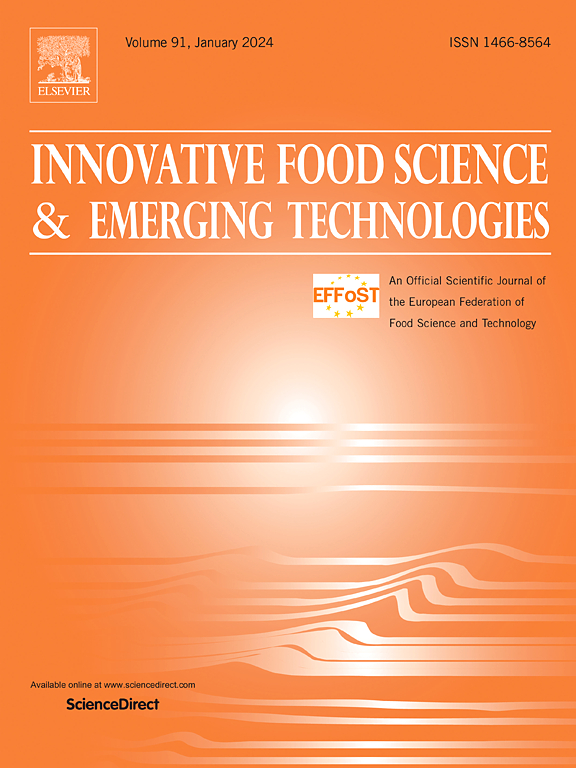欧姆网:基于高级神经网络的酱料粘度预测,用于高效欧姆加热处理
IF 6.8
1区 农林科学
Q1 FOOD SCIENCE & TECHNOLOGY
Innovative Food Science & Emerging Technologies
Pub Date : 2025-06-26
DOI:10.1016/j.ifset.2025.104099
引用次数: 0
摘要
工业食品加工,如欧姆加热(OH)由于其低碳排放和提高能源效率而越来越受欢迎。OH的有效性在很大程度上取决于食品的导电性、物理性质和流变特性,动态粘度直接影响连续流欧姆加热(coh)系统中的流体流动、停留时间和加热速度。因此,在CFOH加工过程中准确预测粘度对于优化加热效率和保持所需的输出温度至关重要,从而最终降低能耗和运营成本。为了应对这一挑战,本研究引入了OhmNet——一种先进的基于神经网络(NN)的预测模型,旨在准确估计氢氧根过程中tikka酱的动态粘度,为氢氧根应用中的粘度预测提供了一个强大的解决方案。该预测模型是利用从加热实验中获得的实时数据开发的,其中粘度测量是在不同的目标温度下使用流变仪记录的。为了实现OhmNet的优化配置,研究了三种不同的方法:针对每个目标温度单独开发网络、基于迁移学习的神经网络和基于单热编码的统一神经网络模型。通过对超参数调整的网格搜索,系统地评估了这些方法,以确定连续流动欧姆加热过程中最准确、最稳健的动态粘度预测模型。所得的OhmNet模型表现出高性能和可靠性,均方误差(MSE)为0.002,平均绝对误差(MAE)为0.025,决定系数(R2)为0.99。OhmNet的这种最佳配置为提高工业食品加工应用的过程效率和控制提供了强大的工具。未来,该模型可以与先进的过程控制器无缝集成,以实现精确的温度控制和功耗优化,推动可持续和节能的食品加工应用。本文章由计算机程序翻译,如有差异,请以英文原文为准。
OhmNet: Advanced neural network-based viscosity prediction of sauces for efficient Ohmic heating processing
Industrial food processes such as Ohmic Heating (OH) are gaining popularity due to their lower carbon emissions and improved energy efficiency. The effectiveness of OH largely depends on the electrical conductivity, physical properties, and rheological characteristics of the food product, with dynamic viscosity directly influencing the fluid flow, residence time, and heating rate in a Continuous Flow Ohmic Heating (CFOH) system. Therefore, accurate prediction of viscosity during CFOH processing is crucial for optimising heating efficiency and maintaining the desired output temperature, ultimately reducing energy consumption and operational costs. To address this challenge, this study introduces OhmNet - an advanced Neural Network (NN)-based predictive model designed to accurately estimate the dynamic viscosity of tikka sauce during OH, offering a robust solution for viscosity prediction in CFOH applications. The predictive model has been developed using real-time data obtained from heating experiments, where viscosity measurements were recorded using a rheometer at varying target temperatures. To achieve the optimal configuration of OhmNet, three different approaches were explored: separate network development for each target temperature, a transfer learning-based neural network, and a one-hot encoding-based unified neural network model. These approaches were systematically evaluated through a grid search for hyperparameter tuning to identify the most accurate and robust dynamic viscosity predictive model during Continuous Flow Ohmic Heating. The resulting OhmNet model demonstrates high performance and reliability, achieving a Mean Squared Error (MSE) of 0.002, a Mean Absolute Error (MAE) of 0.025, and a coefficient of determination (R2) equal to 0.99. This optimal configuration of OhmNet offers a powerful tool for enhancing process efficiency and control in industrial food processing applications. In the future, the model can be seamlessly integrated with advanced process controllers for precise temperature control and power consumption optimisation, driving sustainable and energy-efficient food processing applications.
求助全文
通过发布文献求助,成功后即可免费获取论文全文。
去求助
来源期刊
CiteScore
12.00
自引率
6.10%
发文量
259
审稿时长
25 days
期刊介绍:
Innovative Food Science and Emerging Technologies (IFSET) aims to provide the highest quality original contributions and few, mainly upon invitation, reviews on and highly innovative developments in food science and emerging food process technologies. The significance of the results either for the science community or for industrial R&D groups must be specified. Papers submitted must be of highest scientific quality and only those advancing current scientific knowledge and understanding or with technical relevance will be considered.

 求助内容:
求助内容: 应助结果提醒方式:
应助结果提醒方式:


